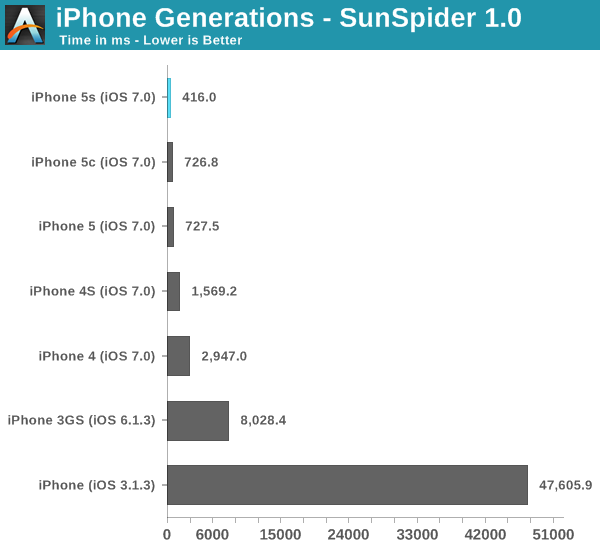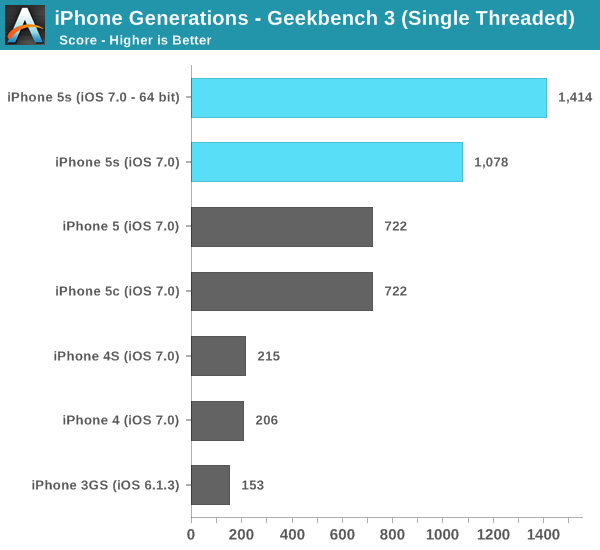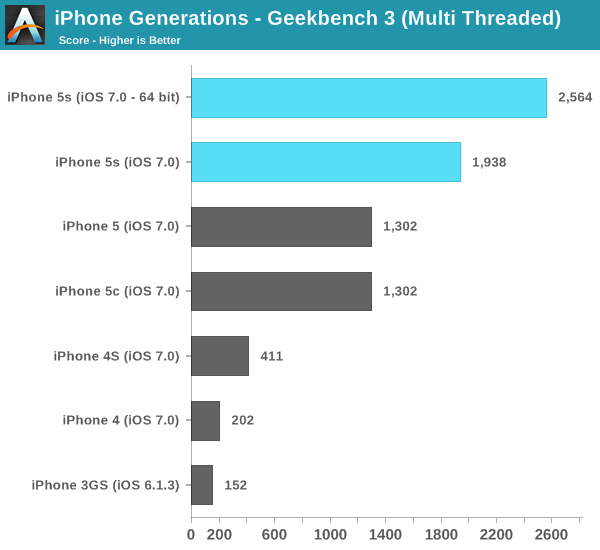The iPhone 5s Review
by Anand Lal Shimpi on September 17, 2013 9:01 PM EST- Posted in
- Smartphones
- Apple
- Mobile
- iPhone
- iPhone 5S
iPhone Performance Across Generations

Performance improved by a factor of 100x compared to the original iPhone. You can cut that in half if the iPhone could run iOS 4. Needless to say, Apple's CPU performance estimates aren't unreasonable. We've come a long way since the days when ARM11 cores were good enough.
Even compared to a relatively modern phone like the iPhone 4, the jump to a 5s is huge. The gap isn't quite at the level of an order of magnitude, but it's quickly approaching it. Using the single core iPhone 4 under iOS 7 just feels incredibly slow. Starting with the 4S things get a lot better, but I'd say the iPhone 4 is at the point now where it's starting to feel too slow even for normal consumers (at least with iOS 7 installed).

Browsermark 2.0 gives us a good indication of less CPU bound performance gains. Here we see over a 5x increase in performance compared to the original iPhone, and an 83% increase compared to the iPhone 4.
I wanted to have a closer look at raw CPU performance so I turned to Geekbench 3. Unfortunately Geekbench 3 won't run on anything older than iOS 6, so the original iPhone bows out of this test.

Single threaded performance scaled by roughly 9x from the 3GS to the iPhone 5s. The improvement since the iPhone 4/4S days is around 6.5x. Single threaded performance often influences snappiness and UI speed/feel, so it's definitely an important vector to scale across.

Take into account multithreaded performance and the increase over the 3GS is even bigger, almost 17x now.
The only 3D test I could get to reliably run across all of the platforms (outside the original iPhone) was Basemark X. Again I had issues getting Basemark X running in offscreen mode on iOS 7 so all of the tests here are run at each device's native resolution. In the case of the 3GS to 4 transition, that means a performance regression as the 3GS had a much lower display resolution to deal with.

Apple has scaled GPU performance pretty much in line with CPU performance over the years. The 5s scores 15x the frame rate of the iPhone 4, at a higher resolution too.
iPhone 5s vs. Bay Trail
I couldn't help but run Intel's current favorite mobile benchmark on the iPhone 5s. WebXPRT by Principled Technologies is a collection of browser based benchmarks that use HTML5 and js to simulate a number of workloads (photo editing, face detection, stocks dashboard and offline notes).

Granted we're comparing across platforms/browsers here, but the 5s as a platform does extremely well in Intel's favorite benchmark. The 5c by comparison performs a lot more like what we'd expect from a smartphone platform. The iPhone 5s is in a league of its own here. While I don't expect performance equalling the Atom Z3770 across the board, the fact that Apple is getting this close (with two fewer cores at that) is a testament to the work done in Cupertino.
At its launch event Apple claimed the A7 offered desktop class CPU performance. If it really is performance competitive with Bay Trail, I think that statement is a fair one to make. We're not talking about Haswell or even Ivy Bridge levels of desktop performance, but rather something close to mobile Core 2 Duo class. I've broken down the subtests in the table below:
| WebXPRT Performance (time in ms, lower is better) | ||||||
| Chrome/Mobile Safari | Photo Effects | Face Detection | Stocks | Offline Notes | ||
| Apple iPhone 5s (Apple A7 1.3GHz) | 878.9 ms | 1831.4 ms | 436.1 ms | 604.6 ms | ||
| Intel Bay Trail FFRD (Atom Z3770 1.46GHz) | 693.5 ms | 1557.0 ms | 542.9 ms | 737.3 ms | ||
| AMD A4-5000 (1.5GHz) | 411.2 ms | 2349.5 ms | 719.1 ms | 880.7 ms | ||
| Apple iPhone 5c (Apple A6 1.3GHz) | 1987.6 ms | 4119.6 ms | 763.6 ms | 1747.6 ms | ||
It's not a clean sweep for the iPhone 5s, but keep in mind that we are comparing to the best AMD and Intel have to offer in this space. I suspect part of why this is close is because both of those companies have been holding back a bit (there's no rush to build the fastest low margin parts), but it doesn't change reality.










464 Comments
View All Comments
ClarkGoble - Wednesday, September 18, 2013 - link
On OSX most apps are 64 bit. Developers I've talked with say you get a 20%-30% speed increase by going 64 bit. Oddly Apple's iWork apps are among the few on my system still 32bit. (And that'll probably change next month) With regards to iOS7 I worry that they didn't increase the RAM but will, for multiprocessing tasks, be having to load both 32bit and 64bit frameworks in RAM at the same time. I assume they have a way to do this well but extra memory would have made it less painful (although perhaps have hurt the battery life)DeciusStrabo - Wednesday, September 18, 2013 - link
Now, now, that's not really true any more. Taking my Windows 8 machine her, about 2/3 of the programs and background processes currently running are 64bit, 1/3 32bit. On MacOS it is more like 90 % 64bit, 10 % 32bit.name99 - Thursday, September 19, 2013 - link
You would get more useful answers if you asked decent questions. What does "bloat your program by 25" mean?- 25% larger CODE footprint?
- 25% larger ACTIVE CODE footprint?
- 25% larger DATA footprint?
- 25% larger ACTIVE DATA footprint?
- 25% larger shipped binary?
The last (shipped binary) is what most people seem to mean when they talk about bloat. It's also the one for which the claim is closest to bullshit because most of what takes up space in a binary is data assets --- images, translated strings, that sort of thing. Even duplicating the code resources to include both 64 and 32 bit code will, for most commercial apps, add only negligible size to the shipping binary.
Devfarce - Tuesday, September 17, 2013 - link
The performance of the A7 chip sounds amazing. Similar performance to the original 11" MBA is pretty incredible. Makes me realize that I have a 2007 Merom 1.8 GHz Core 2 Duo in my laptop, that it's running Win7 32 bit (again!!!!) and that is within striking distance of the iPhone 5s. I don't even want to think about GPU or memory performance, I'm sure that ship sailed long ago with GMA X3100.tipoo - Tuesday, September 17, 2013 - link
Closing in on or maybe surpassing Intel HD2500 now at least, I think. HD4000 is still a bit away, probably within striking range of A7X.dylan522p - Tuesday, September 17, 2013 - link
Hopefully HD6000 is really good. They are doing a big design change then.Krysto - Wednesday, September 18, 2013 - link
Intel will be focusing mostly on power consumption from now on, not performance, even on the GPU side. Although I'm sure they'll try to be misleading again, by showing off the "high-end PC version" of their new GPU, to make everyone think that's what they're getting in their laptops (even though they're not), just like they did with Haswell.Mondozai - Wednesday, September 18, 2013 - link
You have no clue, Krysto.Devfarce - Wednesday, September 18, 2013 - link
I wouldn't say Intel is misleading on performance, however very few companies will demand the parts with the biggest GPU like Apple does. People just don't demand the parts with the big GPUs although they should. Which is why Intel currently sells mostly HD4400 in the windows Haswell chips on the market.But back to the iPhone, this is truly incredible even if people don't want to believe it.
akdj - Thursday, September 19, 2013 - link
Not sure you know what you're talking about. The 5000 & 51(2?)00 iGPUs are incredible. Especially when you take in to count the efficiency and power increase between its (Haswell) architecture in comparison with the HD4000 in Ivy Bridge. I think Apple's demand here is a big motivation for Intel to continue to innovate with their iGPUs...regardless of what the other 'ultra book' OEMs are demanding. They just don't have the pull...or the 'balls' to stand up to Intel. I also think Intel has impressed themselves with the performance gains from the Hd3000--->40000--->>4600/5&5100 transitions. As they progress and shut the gap of what a normal consumer that enjoys gaming and video editing (not the GPU guru that's demanding the latest SLI nVidia setup)...when directly compared with discrete cards, they'll enjoy a big win. Already the ultra book sales are being subsidized by Intel...to the tune of $300,000,000. I think they're motivated and Apple absolutely IS using the high power GPUs. Not the 4600 all others have chosen. The 5000s are already in the new MBA. The rMBP refresh is close and my bet is they'll be using the high end iGPU in the 13/15" rMBP updates. Hopefully still maintaining the discreet option on the 15"...but as the performance increase, in the portable laptop sector....I'm not so sure most consumers wouldn't value all day battery performance vs an extra 10fps in the latest FPS;). The 13" MBA is already getting 10-12 hours of battery life on Haswell with the HD 5000. And able to play triple A games at decent frame rates, albeit not on the 'ultimate' settings with anti aliasing. For those interested, they'll augment their day long use laptop with a gaming console. I think the whole big beige desktop's days are limited. We'll see. While I don't disagree Intel tends to embellish their performance...in this case, they're going the right direction. Too much competition...including from the ultra low voltage SoC developers making such massive in roads (this review is all the proof you need).